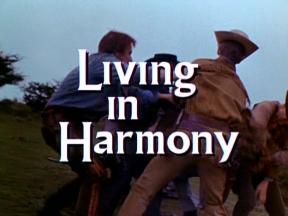 Living In Harmony
Living In HarmonyTransmission Date: 29/12/1967
Episode Length: 48'58m (DVD timing)/50'52m (Blu-Ray timing)
Est. Ratings: 9.3m
Written by: David Tomblin (From a story by David Tomblin and Ian L.Rakoff)
Directed by: David Tomblin
DVD availability: Try amazon.com
Production Commenced:
September 1967
Production Credits:
An ITC Production by Everyman Films Ltd. Producer: David Tomblin; Production Manager: Ronald Liles; Director of Photography: Brendan J. Stafford B.S.C.; Art Director: Jack Shampan; Camera Operator: Len Harris; Editor: Noreen Ackland G.B.P.E.; Theme: Ron Grainer; Musical Director: Albert Elms; Assistant Director: Gino Marotta; Sound Editor: Will Thompson; Sound Recordist: Cyril Swern; Music Editor: Eric Mival; Casting Director: Rose Tobias-Shaw; Set Dresser: John Lageu; Continuity: Phyllis Townshend; Make-Up: Frank Turner; Hairdressing: Olive Mills and Wardrobe: Dora Lloyd. Made on location and at Metro-Goldwyn-Mayer Studios, Borehamwood, England.
Starring:
Patrick McGoohan (The Prisoner); Alexis Kanner (The Kid); David Bauer (The Judge); Valerie French (Kathy); Gordon Tanner (Town Elder); Gordon Sterne (Bystander); Michael Balfour (Will); Larry Taylor (Mexican Sam); Monti Delyle (Town Dignitary); Douglas Jones (Horse Dealer); Bill Nick(First Gunman); Les Crawford (Second Gunman); Frank Maher (Third Gunman); Max Faulkner (First Horseman); Bill Cummings (Second Horseman); Eddie Eddon (Third Horseman); Peter Brace (Zeke, uncredited); Peter Brayham (Cowboy Thug, uncredited); Gary Maher (Little Boy, uncredited) and Robert Rietty (Character Voices, uncredited)
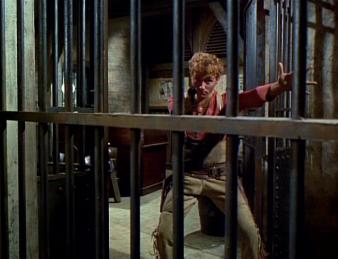
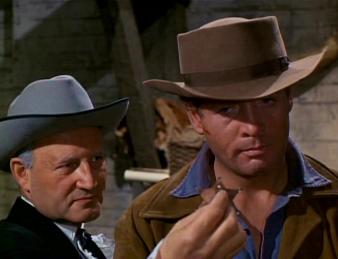
Storyline:
A man passes through the town of Harmony, and, despite his attempts to escape, is constantly dragged back. He is called upon by the town Judge to become the new Sheriff, and the town will not accept his resignation. Ultimately, seeing a resident of the town, Katherine Johnston, hounded by a mute, psychotic "kid" and her brother hung makes the Sheriff decide to leave - and take her with him. However, she is murdered by "the kid", and his only help, a localman named "Jim" has also been slain by the Judge's men. He re-enters the local bar, The Silver Dollar (advertising sales of "Prickley Pear Beer") and becomes involved in a shoot-out with the Judge and his men. The ex-Sheriff guns down the Judge's men, but glances upwards and is shot dead by the Judge.
Escape:
No.6 awakes to find that the whole thing has been an illusion - he is the Sheriff, No.2 is the Judge, and "the kid" and Kathy are No.2's helpers. Situating him in a mock-up of a western town with cardboard cut outs and radio communication to help the illusion, the whole thing has been a hallucination in order to make him crack.
However, No.2's chief assistant became so involved with his work the character of "the kid" takes over and he kills "Kathy" for real. No.6 walks away as "the kid" commits suicide, leaving No.2 alone...
Trivia:
Writer Ian Rakoff was approached personally by McGoohan to write a western for him. The title was lifted from a Marvel comic of around the period, possibly either Two Gun Kid or Kid Colt � Outlaw; while the title was contained within one of the stories. Also, the scene where McGoohan is attacked while wearing the saddle on his shoulder was lifted from a Gene Autry comic.
Though the atmosphere on set generally became more strained towards the end of production, Living In Harmony was a relatively peaceful shoot. David Tomblin, who has since gone on to become Assistant Director on such major motion pictures as Braveheart, The Empire Strikes Back, Return of the Jedi and the two Indiana Jones sequels, was proud to have made the first British western on film. McGoohan, meanwhile, was excited about Alexis Kanner, even going so far as to place his name in a special box and give him roles in both remaining episodes to be filmed (The Girl Who Was Death and Fall Out, Once Upon A Time having been filmed some months previously). This was also around the same time the series was due to start broadcasting, and just before making this episode McGoohan had attended a bizarre press conference, locked in a cage in a "Kosho" outfit and the cowboy one seen here. Small tensions, however, did arise when the notoriously prudish McGoohan saw the cleavage-enhancing costume Valerie French wears in the western scenes and tried to insert as many shadows as possible to cover her chest.
For the only time there is no title sequence, the action begins unprompted, and after 81 seconds "Living In Harmony" is overlaid on the picture. The Prisoner is not mentioned at all. This is also the first time McGoohan recieves a role credit (although I list him as "The Prisoner" on each of these guides, he is normally credited for acting at the beginning of each episode, with a "starring Patrick McGoohan" during the opening titles). Apart from Fall Out, this is probably the most controversial episode, not screened in America during Vietnam, with its anti-gun politics, and even censored in England until 1984.
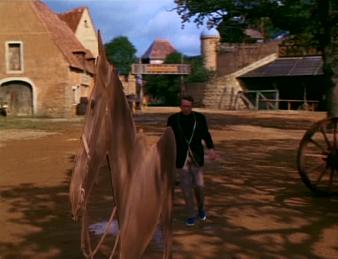
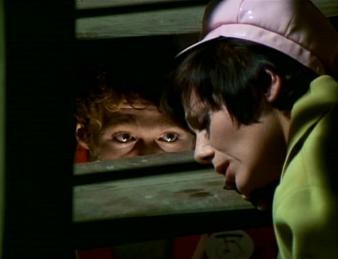
"I agreed to wear the badge but not the gun."
Viewpoint:
I�ve always had a lot of love for Living In Harmony, an inessential yet thoroughly entertaining episode of The Prisoner.
Most of the characters and situations, including the stereotyped Mexican, are as phony as McGoohan�s US accent (perhaps a little odd, considering that Pat is technically an American) but they�re such good fun it scarcely seems to matter. Though this is the first of two fantasy episodes and Portmerion has long been abandoned, the scale and ambition of the first British western shot on film is immense.
David Tomblin�s direction is, in fact, so good you can�t help but wonder what it would have been like if he�d directed the entire series. His cinematic vocabulary is far more sophisticated than many, if not all, of the other Prisoner directors. He�s helped by the performances, including the mime-like Kanner and the impressive use of lighting. Harmony is probably the (literally) darkest episode of the lot, including extensive night filming.
Astonishingly this exceptionally violent episode � which contains multiple beatings, hangings, shootings and attempted rape � gets away with a �PG� certificate in UK territories. The final twist � the Village is running a kind of virtual reality � is ahead of its time and the switch to a western setting with no explanation, not even a credits sequence, must have confused viewers even further. Let�s not even get into the fact that the entire enterprise can be read as a subtle allegory on Vietnam. For what is ostensibly a �filler� episode of The Prisoner, Living In Harmony still has plenty to say.



